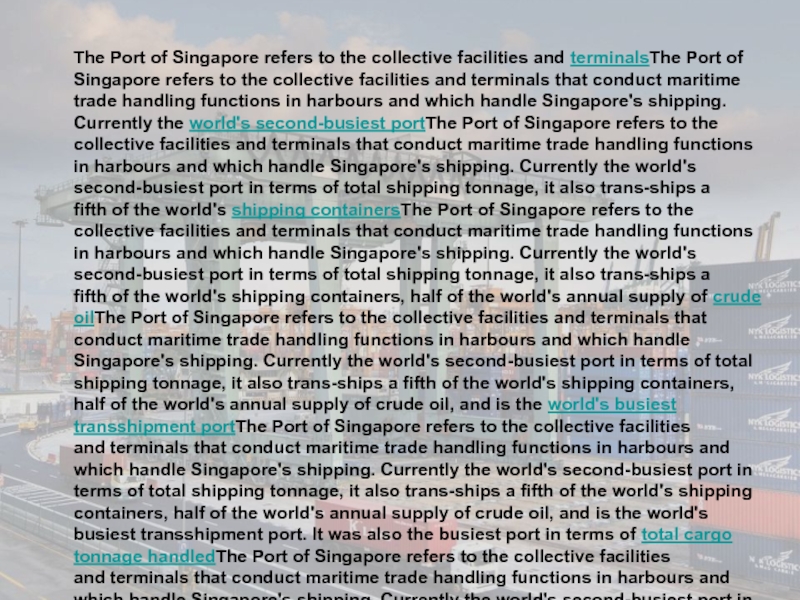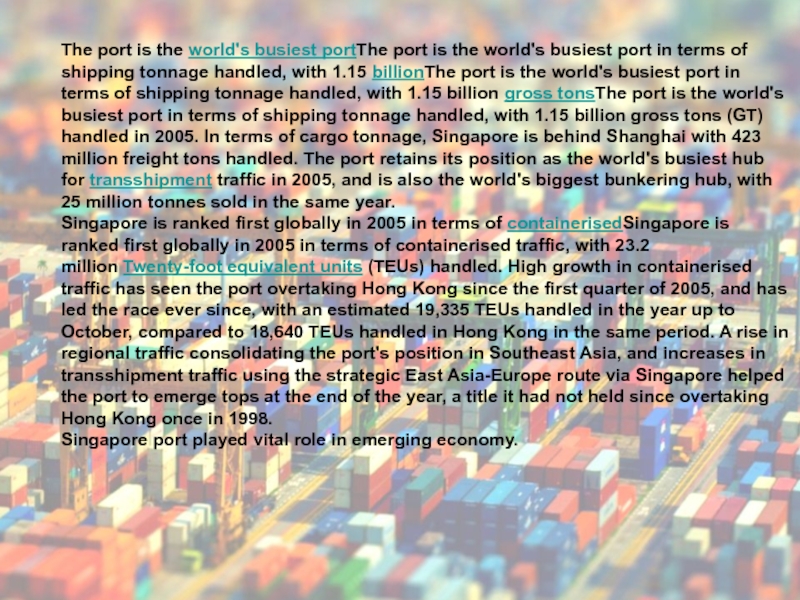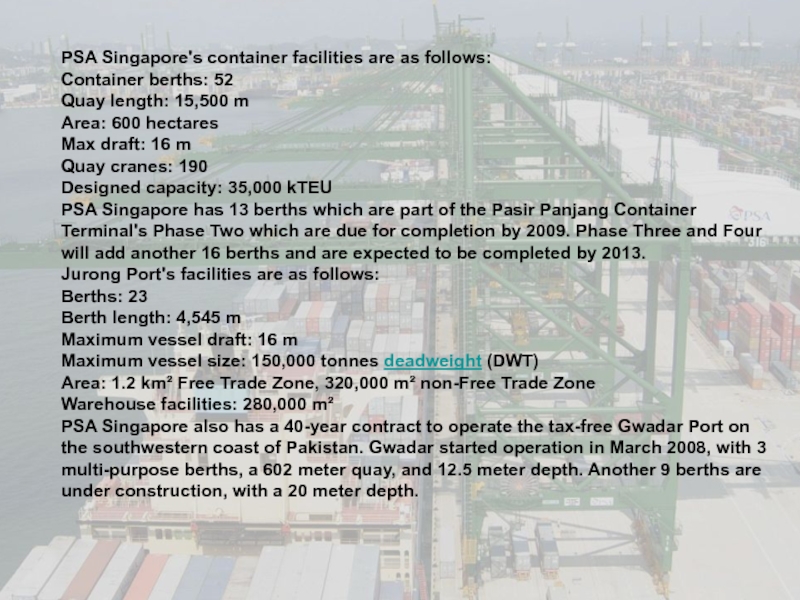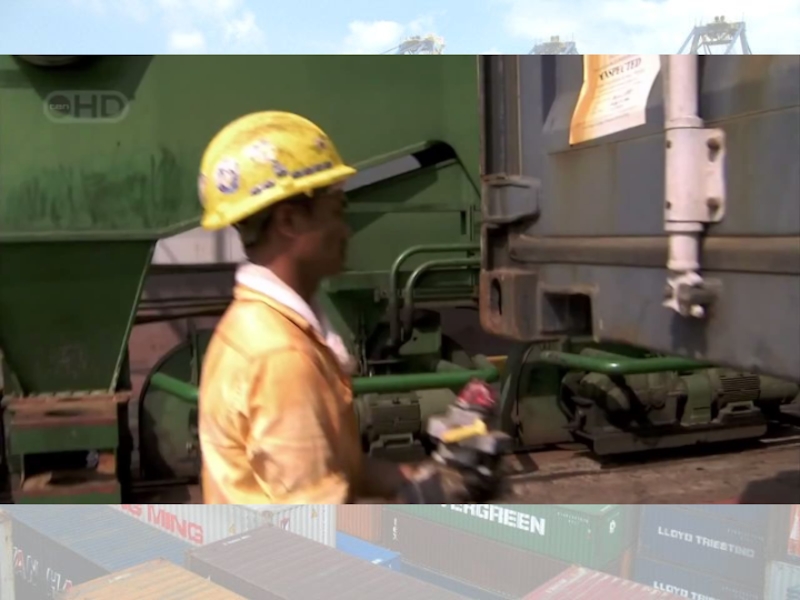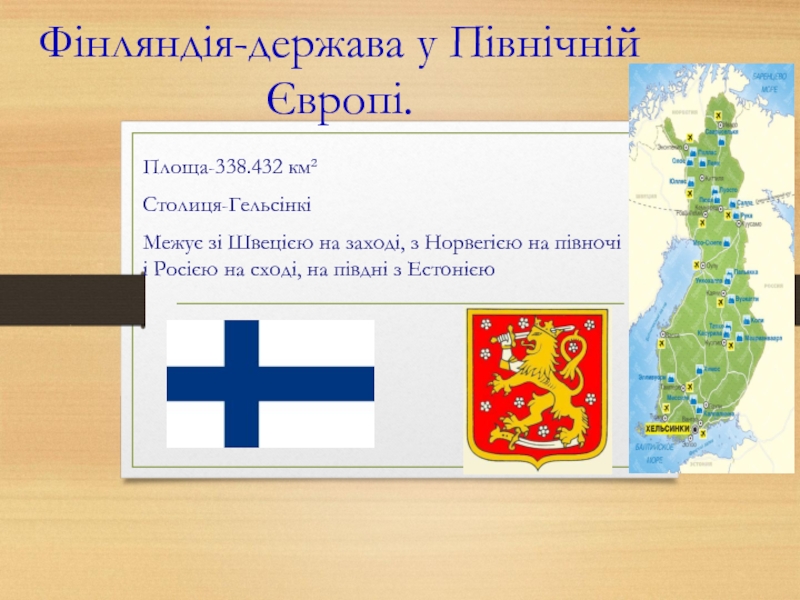the collective facilities and terminals that conduct maritime trade handling functions in harbours and which handle Singapore's shipping. Currently the world's second-busiest portThe Port of Singapore refers to the collective facilities and terminals that conduct maritime trade handling functions in harbours and which handle Singapore's shipping. Currently the world's second-busiest port in terms of total shipping tonnage, it also trans-ships a fifth of the world's shipping containersThe Port of Singapore refers to the collective facilities and terminals that conduct maritime trade handling functions in harbours and which handle Singapore's shipping. Currently the world's second-busiest port in terms of total shipping tonnage, it also trans-ships a fifth of the world's shipping containers, half of the world's annual supply of crude oilThe Port of Singapore refers to the collective facilities and terminals that conduct maritime trade handling functions in harbours and which handle Singapore's shipping. Currently the world's second-busiest port in terms of total shipping tonnage, it also trans-ships a fifth of the world's shipping containers, half of the world's annual supply of crude oil, and is the world's busiest transshipment portThe Port of Singapore refers to the collective facilities and terminals that conduct maritime trade handling functions in harbours and which handle Singapore's shipping. Currently the world's second-busiest port in terms of total shipping tonnage, it also trans-ships a fifth of the world's shipping containers, half of the world's annual supply of crude oil, and is the world's busiest transshipment port. It was also the busiest port in terms of total cargo tonnage handledThe Port of Singapore refers to the collective facilities and terminals that conduct maritime trade handling functions in harbours and which handle Singapore's shipping. Currently the world's second-busiest port in terms of total shipping tonnage, it also trans-ships a fifth of the world's shipping containers, half of the world's annual supply of crude oil, and is the world's busiest transshipment port. It was also the busiest port in terms of total cargo tonnage handled until 2005, when it was surpassed by the Port of Shanghai. Thousands of ships drop anchor in the harbour, connecting the port to over 600 other ports in 123 countries and spread over six continents.
The Port of Singapore is not a mere economic boon, but an economic necessity because Singapore is lacking in landThe Port of Singapore is not a mere economic boon, but an economic necessity because Singapore is lacking in land andnatural resourcesThe Port of Singapore is not a mere economic boon, but an economic necessity because Singapore is lacking in land andnatural resources. The Port is critical for importing natural resources, and then later re-exporting products after they have been refined and shaped in some manner, for example wafer fabricationThe Port of Singapore is not a mere economic boon, but an economic necessity because Singapore is lacking in land andnatural resources. The Port is critical for importing natural resources, and then later re-exporting products after they have been refined and shaped in some manner, for example wafer fabrication or oil refiningThe Port of Singapore is not a mere economic boon, but an economic necessity because Singapore is lacking in land andnatural resources. The Port is critical for importing natural resources, and then later re-exporting products after they have been refined and shaped in some manner, for example wafer fabrication or oil refining to generate revenue. The service industriesThe Port of Singapore is not a mere economic boon, but an economic necessity because Singapore is lacking in land andnatural resources. The Port is critical for importing natural resources, and then later re-exporting products after they have been refined and shaped in some manner, for example wafer fabrication or oil refining to generate revenue. The service industries such as hospitality services typical of a port of callThe Port of Singapore is not a mere economic boon, but an economic necessity because Singapore is lacking in land andnatural resources. The Port is critical for importing natural resources, and then later re-exporting products after they have been refined and shaped in some manner, for example wafer fabrication or oil refining to generate revenue. The service industries such as hospitality services typical of a port of call restock the food and water supplies on ships. Ships pass between the Indian Ocean and the Pacific Ocean through the Singapore Strait. The Straits of JohorThe Port of Singapore is not a mere economic boon, but an economic necessity because Singapore is lacking in land andnatural resources. The Port is critical for importing natural resources, and then later re-exporting products after they have been refined and shaped in some manner, for example wafer fabrication or oil refining to generate revenue. The service industries such as hospitality services typical of a port of call restock the food and water supplies on ships. Ships pass between the Indian Ocean and the Pacific Ocean through the Singapore Strait. The Straits of Johor on the country's north are impassable for ships due to the Johor-Singapore Causeway, built in 1923, which links the city of Woodlands, Singapore to Johor Bahru in Malaysia.
- Главная
- Разное
- Дизайн
- Бизнес и предпринимательство
- Аналитика
- Образование
- Развлечения
- Красота и здоровье
- Финансы
- Государство
- Путешествия
- Спорт
- Недвижимость
- Армия
- Графика
- Культурология
- Еда и кулинария
- Лингвистика
- Английский язык
- Астрономия
- Алгебра
- Биология
- География
- Детские презентации
- Информатика
- История
- Литература
- Маркетинг
- Математика
- Медицина
- Менеджмент
- Музыка
- МХК
- Немецкий язык
- ОБЖ
- Обществознание
- Окружающий мир
- Педагогика
- Русский язык
- Технология
- Физика
- Философия
- Химия
- Шаблоны, картинки для презентаций
- Экология
- Экономика
- Юриспруденция
Singapore презентация
Содержание
Слайд 2 The Port of Singapore refers to the collective facilities and terminalsThe Port of Singapore refers to
Слайд 3
Before 1819
In the late 13th century, a settlement known as Singapore
was established on the north bank of the Singapore RiverIn the late 13th century, a settlement known as Singapore was established on the north bank of the Singapore River around what was called the Old Harbour. It was the only port in the southern part of the Strait of MalaccaIn the late 13th century, a settlement known as Singapore was established on the north bank of the Singapore River around what was called the Old Harbour. It was the only port in the southern part of the Strait of Malacca and serviced ships and traders in the region, competing with other ports along the coast of the Malacca Strait such as JambiIn the late 13th century, a settlement known as Singapore was established on the north bank of the Singapore River around what was called the Old Harbour. It was the only port in the southern part of the Strait of Malacca and serviced ships and traders in the region, competing with other ports along the coast of the Malacca Strait such as Jambi, Kota Cina, Lambri, Semudra, PalembangIn the late 13th century, a settlement known as Singapore was established on the north bank of the Singapore River around what was called the Old Harbour. It was the only port in the southern part of the Strait of Malacca and serviced ships and traders in the region, competing with other ports along the coast of the Malacca Strait such as Jambi, Kota Cina, Lambri, Semudra, Palembang, South Kedah and Tamiang. The port had two functions. First, it made available products that were in demand by international markets; according to the Daoyu Zhilüe (Brief Annals of Foreign Islands, 1349) by Chinese trader Wang Dayuan (born 1311, fl. 1328–1339), these included top-quality hornbill 1328–1339), these included top-quality hornbill casques, lakawood 1328–1339), these included top-quality hornbill casques, lakawood and cotton. Although these goods were also available from other Southeast Asian ports, those from Singapore were unique in terms of their quality. Secondly, Singapore acted as a gateway into the regional and international economic system for its immediate region. South Johor 1328–1339), these included top-quality hornbill casques, lakawood and cotton. Although these goods were also available from other Southeast Asian ports, those from Singapore were unique in terms of their quality. Secondly, Singapore acted as a gateway into the regional and international economic system for its immediate region. South Johor and the Riau Archipelago 1328–1339), these included top-quality hornbill casques, lakawood and cotton. Although these goods were also available from other Southeast Asian ports, those from Singapore were unique in terms of their quality. Secondly, Singapore acted as a gateway into the regional and international economic system for its immediate region. South Johor and the Riau Archipelago supplied products to Singapore for export elsewhere, while Singapore was the main source of foreign products to the region. Archaeological artefacts such as ceramics and glassware found in the Riau Archipelago evidence this. In addition, cotton was transshipped from Java or India through Singapore.
Слайд 4
1819–1963
Keen to attract Asian and European traders to the new port,
Raffles directed that land along the banks of the Singapore River, particularly the south bank, be reclaimed where necessary and allocated to Chinese and English country traders to encourage them to establish a stake in the port-settlement. Chinese traders, because of their frequent commercial interactions with Southeast Asian traders throughout the year, set up their trading houses along the lower reaches of the river, while English country traders, who depended on the annual arrival of trade from India, set up warehouses along the upper reaches. The port relied on three main networks of trade that existed in Southeast Asia at that time: the Chinese network, which linked Southeast Asia with the southern Chinese ports of FujianKeen to attract Asian and European traders to the new port, Raffles directed that land along the banks of the Singapore River, particularly the south bank, be reclaimed where necessary and allocated to Chinese and English country traders to encourage them to establish a stake in the port-settlement. Chinese traders, because of their frequent commercial interactions with Southeast Asian traders throughout the year, set up their trading houses along the lower reaches of the river, while English country traders, who depended on the annual arrival of trade from India, set up warehouses along the upper reaches. The port relied on three main networks of trade that existed in Southeast Asia at that time: the Chinese network, which linked Southeast Asia with the southern Chinese ports of Fujian and GuangdongKeen to attract Asian and European traders to the new port, Raffles directed that land along the banks of the Singapore River, particularly the south bank, be reclaimed where necessary and allocated to Chinese and English country traders to encourage them to establish a stake in the port-settlement. Chinese traders, because of their frequent commercial interactions with Southeast Asian traders throughout the year, set up their trading houses along the lower reaches of the river, while English country traders, who depended on the annual arrival of trade from India, set up warehouses along the upper reaches. The port relied on three main networks of trade that existed in Southeast Asia at that time: the Chinese network, which linked Southeast Asia with the southern Chinese ports of Fujian and Guangdong; the Southeast Asian network, which linked the islands of the Indonesian archipelagoKeen to attract Asian and European traders to the new port, Raffles directed that land along the banks of the Singapore River, particularly the south bank, be reclaimed where necessary and allocated to Chinese and English country traders to encourage them to establish a stake in the port-settlement. Chinese traders, because of their frequent commercial interactions with Southeast Asian traders throughout the year, set up their trading houses along the lower reaches of the river, while English country traders, who depended on the annual arrival of trade from India, set up warehouses along the upper reaches. The port relied on three main networks of trade that existed in Southeast Asia at that time: the Chinese network, which linked Southeast Asia with the southern Chinese ports of Fujian and Guangdong; the Southeast Asian network, which linked the islands of the Indonesian archipelago; and the European and Indian Ocean network, which linked Singapore to the markets of Europe and the Indian Ocean littoralKeen to attract Asian and European traders to the new port, Raffles directed that land along the banks of the Singapore River, particularly the south bank, be reclaimed where necessary and allocated to Chinese and English country traders to encourage them to establish a stake in the port-settlement. Chinese traders, because of their frequent commercial interactions with Southeast Asian traders throughout the year, set up their trading houses along the lower reaches of the river, while English country traders, who depended on the annual arrival of trade from India, set up warehouses along the upper reaches. The port relied on three main networks of trade that existed in Southeast Asia at that time: the Chinese network, which linked Southeast Asia with the southern Chinese ports of Fujian and Guangdong; the Southeast Asian network, which linked the islands of the Indonesian archipelago; and the European and Indian Ocean network, which linked Singapore to the markets of Europe and the Indian Ocean littoral. These networks were complementary, and positioned Singapore as the transshipment point of regional and international trade. By the 1830s, Singapore had overtaken Batavia (now JakartaKeen to attract Asian and European traders to the new port, Raffles directed that land along the banks of the Singapore River, particularly the south bank, be reclaimed where necessary and allocated to Chinese and English country traders to encourage them to establish a stake in the port-settlement. Chinese traders, because of their frequent commercial interactions with Southeast Asian traders throughout the year, set up their trading houses along the lower reaches of the river, while English country traders, who depended on the annual arrival of trade from India, set up warehouses along the upper reaches. The port relied on three main networks of trade that existed in Southeast Asia at that time: the Chinese network, which linked Southeast Asia with the southern Chinese ports of Fujian and Guangdong; the Southeast Asian network, which linked the islands of the Indonesian archipelago; and the European and Indian Ocean network, which linked Singapore to the markets of Europe and the Indian Ocean littoral. These networks were complementary, and positioned Singapore as the transshipment point of regional and international trade. By the 1830s, Singapore had overtaken Batavia (now Jakarta) as the centre of the Chinese junkKeen to attract Asian and European traders to the new port, Raffles directed that land along the banks of the Singapore River, particularly the south bank, be reclaimed where necessary and allocated to Chinese and English country traders to encourage them to establish a stake in the port-settlement. Chinese traders, because of their frequent commercial interactions with Southeast Asian traders throughout the year, set up their trading houses along the lower reaches of the river, while English country traders, who depended on the annual arrival of trade from India, set up warehouses along the upper reaches. The port relied on three main networks of trade that existed in Southeast Asia at that time: the Chinese network, which linked Southeast Asia with the southern Chinese ports of Fujian and Guangdong; the Southeast Asian network, which linked the islands of the Indonesian archipelago; and the European and Indian Ocean network, which linked Singapore to the markets of Europe and the Indian Ocean littoral. These networks were complementary, and positioned Singapore as the transshipment point of regional and international trade. By the 1830s, Singapore had overtaken Batavia (now Jakarta) as the centre of the Chinese junk trade, and also become the centre of English country trade, in Southeast Asia. This was because Southeast Asian traders preferred the free portKeen to attract Asian and European traders to the new port, Raffles directed that land along the banks of the Singapore River, particularly the south bank, be reclaimed where necessary and allocated to Chinese and English country traders to encourage them to establish a stake in the port-settlement. Chinese traders, because of their frequent commercial interactions with Southeast Asian traders throughout the year, set up their trading houses along the lower reaches of the river, while English country traders, who depended on the annual arrival of trade from India, set up warehouses along the upper reaches. The port relied on three main networks of trade that existed in Southeast Asia at that time: the Chinese network, which linked Southeast Asia with the southern Chinese ports of Fujian and Guangdong; the Southeast Asian network, which linked the islands of the Indonesian archipelago; and the European and Indian Ocean network, which linked Singapore to the markets of Europe and the Indian Ocean littoral. These networks were complementary, and positioned Singapore as the transshipment point of regional and international trade. By the 1830s, Singapore had overtaken Batavia (now Jakarta) as the centre of the Chinese junk trade, and also become the centre of English country trade, in Southeast Asia. This was because Southeast Asian traders preferred the free port of Singapore to other major regional ports which had cumbersome restrictions. Singapore had also supplanted Tanjung PinangKeen to attract Asian and European traders to the new port, Raffles directed that land along the banks of the Singapore River, particularly the south bank, be reclaimed where necessary and allocated to Chinese and English country traders to encourage them to establish a stake in the port-settlement. Chinese traders, because of their frequent commercial interactions with Southeast Asian traders throughout the year, set up their trading houses along the lower reaches of the river, while English country traders, who depended on the annual arrival of trade from India, set up warehouses along the upper reaches. The port relied on three main networks of trade that existed in Southeast Asia at that time: the Chinese network, which linked Southeast Asia with the southern Chinese ports of Fujian and Guangdong; the Southeast Asian network, which linked the islands of the Indonesian archipelago; and the European and Indian Ocean network, which linked Singapore to the markets of Europe and the Indian Ocean littoral. These networks were complementary, and positioned Singapore as the transshipment point of regional and international trade. By the 1830s, Singapore had overtaken Batavia (now Jakarta) as the centre of the Chinese junk trade, and also become the centre of English country trade, in Southeast Asia. This was because Southeast Asian traders preferred the free port of Singapore to other major regional ports which had cumbersome restrictions. Singapore had also supplanted Tanjung Pinang as the export gateway for the gambierKeen to attract Asian and European traders to the new port, Raffles directed that land along the banks of the Singapore River, particularly the south bank, be reclaimed where necessary and allocated to Chinese and English country traders to encourage them to establish a stake in the port-settlement. Chinese traders, because of their frequent commercial interactions with Southeast Asian traders throughout the year, set up their trading houses along the lower reaches of the river, while English country traders, who depended on the annual arrival of trade from India, set up warehouses along the upper reaches. The port relied on three main networks of trade that existed in Southeast Asia at that time: the Chinese network, which linked Southeast Asia with the southern Chinese ports of Fujian and Guangdong; the Southeast Asian network, which linked the islands of the Indonesian archipelago; and the European and Indian Ocean network, which linked Singapore to the markets of Europe and the Indian Ocean littoral. These networks were complementary, and positioned Singapore as the transshipment point of regional and international trade. By the 1830s, Singapore had overtaken Batavia (now Jakarta) as the centre of the Chinese junk trade, and also become the centre of English country trade, in Southeast Asia. This was because Southeast Asian traders preferred the free port of Singapore to other major regional ports which had cumbersome restrictions. Singapore had also supplanted Tanjung Pinang as the export gateway for the gambier and pepper industry of the RiauKeen to attract Asian and European traders to the new port, Raffles directed that land along the banks of the Singapore River, particularly the south bank, be reclaimed where necessary and allocated to Chinese and English country traders to encourage them to establish a stake in the port-settlement. Chinese traders, because of their frequent commercial interactions with Southeast Asian traders throughout the year, set up their trading houses along the lower reaches of the river, while English country traders, who depended on the annual arrival of trade from India, set up warehouses along the upper reaches. The port relied on three main networks of trade that existed in Southeast Asia at that time: the Chinese network, which linked Southeast Asia with the southern Chinese ports of Fujian and Guangdong; the Southeast Asian network, which linked the islands of the Indonesian archipelago; and the European and Indian Ocean network, which linked Singapore to the markets of Europe and the Indian Ocean littoral. These networks were complementary, and positioned Singapore as the transshipment point of regional and international trade. By the 1830s, Singapore had overtaken Batavia (now Jakarta) as the centre of the Chinese junk trade, and also become the centre of English country trade, in Southeast Asia. This was because Southeast Asian traders preferred the free port of Singapore to other major regional ports which had cumbersome restrictions. Singapore had also supplanted Tanjung Pinang as the export gateway for the gambier and pepper industry of the Riau–LinggaKeen to attract Asian and European traders to the new port, Raffles directed that land along the banks of the Singapore River, particularly the south bank, be reclaimed where necessary and allocated to Chinese and English country traders to encourage them to establish a stake in the port-settlement. Chinese traders, because of their frequent commercial interactions with Southeast Asian traders throughout the year, set up their trading houses along the lower reaches of the river, while English country traders, who depended on the annual arrival of trade from India, set up warehouses along the upper reaches. The port relied on three main networks of trade that existed in Southeast Asia at that time: the Chinese network, which linked Southeast Asia with the southern Chinese ports of Fujian and Guangdong; the Southeast Asian network, which linked the islands of the Indonesian archipelago; and the European and Indian Ocean network, which linked Singapore to the markets of Europe and the Indian Ocean littoral. These networks were complementary, and positioned Singapore as the transshipment point of regional and international trade. By the 1830s, Singapore had overtaken Batavia (now Jakarta) as the centre of the Chinese junk trade, and also become the centre of English country trade, in Southeast Asia. This was because Southeast Asian traders preferred the free port of Singapore to other major regional ports which had cumbersome restrictions. Singapore had also supplanted Tanjung Pinang as the export gateway for the gambier and pepper industry of the Riau–Lingga Archipelago by the 1830s, and South Johor by the 1840s. It had also become the centre of the Teochew trade in marine produce and rice.
Слайд 5
Since 1963
Singapore ceased to be part of the British EmpireSingapore ceased to
be part of the British Empire when it merged with MalaysiaSingapore ceased to be part of the British Empire when it merged with Malaysia in 1963. Singapore lost its hinterland and was no longer the administrative or economic capital of the Malay Peninsula. The processing in Singapore of raw materials extracted in the Peninsula was drastically reduced due to the absence of a common market between Singapore and the Peninsular states.
Since Singapore's full independence in 1965, it has had to compete with other ports in the region to attract shipping and trade at its port. It has done so by developing an export-oriented economy based on value-added manufacturing. It obtains raw or partially manufactured products from regional and global markets and exports value-added products back to these markets through market access agreements such as World Trade OrganizationSince Singapore's full independence in 1965, it has had to compete with other ports in the region to attract shipping and trade at its port. It has done so by developing an export-oriented economy based on value-added manufacturing. It obtains raw or partially manufactured products from regional and global markets and exports value-added products back to these markets through market access agreements such as World Trade Organization directives and free trade agreements.
By the 1980s, maritime trading activity had ceased in the vicinity of the Singapore River except in the form of passenger transport, as other terminals and harbours took over this role. Keppel Harbour is now home to three container terminalsBy the 1980s, maritime trading activity had ceased in the vicinity of the Singapore River except in the form of passenger transport, as other terminals and harbours took over this role. Keppel Harbour is now home to three container terminals. Other terminals were built in JurongBy the 1980s, maritime trading activity had ceased in the vicinity of the Singapore River except in the form of passenger transport, as other terminals and harbours took over this role. Keppel Harbour is now home to three container terminals. Other terminals were built in Jurong and Pasir PanjangBy the 1980s, maritime trading activity had ceased in the vicinity of the Singapore River except in the form of passenger transport, as other terminals and harbours took over this role. Keppel Harbour is now home to three container terminals. Other terminals were built in Jurong and Pasir Panjang as well as in SembawangBy the 1980s, maritime trading activity had ceased in the vicinity of the Singapore River except in the form of passenger transport, as other terminals and harbours took over this role. Keppel Harbour is now home to three container terminals. Other terminals were built in Jurong and Pasir Panjang as well as in Sembawang in the north. Today, the port operations in Singapore are handled by two players: PSA InternationalBy the 1980s, maritime trading activity had ceased in the vicinity of the Singapore River except in the form of passenger transport, as other terminals and harbours took over this role. Keppel Harbour is now home to three container terminals. Other terminals were built in Jurong and Pasir Panjang as well as in Sembawang in the north. Today, the port operations in Singapore are handled by two players: PSA International (formerly the Port of Singapore Authority) and Jurong Port, which collectively operate six container terminals and three general-purpose terminals around Singapore.
In the 1990s the Port became more well-known and overtook Yokohama, and eventually became the busiest port in terms of shipping tonnage.
Since Singapore's full independence in 1965, it has had to compete with other ports in the region to attract shipping and trade at its port. It has done so by developing an export-oriented economy based on value-added manufacturing. It obtains raw or partially manufactured products from regional and global markets and exports value-added products back to these markets through market access agreements such as World Trade OrganizationSince Singapore's full independence in 1965, it has had to compete with other ports in the region to attract shipping and trade at its port. It has done so by developing an export-oriented economy based on value-added manufacturing. It obtains raw or partially manufactured products from regional and global markets and exports value-added products back to these markets through market access agreements such as World Trade Organization directives and free trade agreements.
By the 1980s, maritime trading activity had ceased in the vicinity of the Singapore River except in the form of passenger transport, as other terminals and harbours took over this role. Keppel Harbour is now home to three container terminalsBy the 1980s, maritime trading activity had ceased in the vicinity of the Singapore River except in the form of passenger transport, as other terminals and harbours took over this role. Keppel Harbour is now home to three container terminals. Other terminals were built in JurongBy the 1980s, maritime trading activity had ceased in the vicinity of the Singapore River except in the form of passenger transport, as other terminals and harbours took over this role. Keppel Harbour is now home to three container terminals. Other terminals were built in Jurong and Pasir PanjangBy the 1980s, maritime trading activity had ceased in the vicinity of the Singapore River except in the form of passenger transport, as other terminals and harbours took over this role. Keppel Harbour is now home to three container terminals. Other terminals were built in Jurong and Pasir Panjang as well as in SembawangBy the 1980s, maritime trading activity had ceased in the vicinity of the Singapore River except in the form of passenger transport, as other terminals and harbours took over this role. Keppel Harbour is now home to three container terminals. Other terminals were built in Jurong and Pasir Panjang as well as in Sembawang in the north. Today, the port operations in Singapore are handled by two players: PSA InternationalBy the 1980s, maritime trading activity had ceased in the vicinity of the Singapore River except in the form of passenger transport, as other terminals and harbours took over this role. Keppel Harbour is now home to three container terminals. Other terminals were built in Jurong and Pasir Panjang as well as in Sembawang in the north. Today, the port operations in Singapore are handled by two players: PSA International (formerly the Port of Singapore Authority) and Jurong Port, which collectively operate six container terminals and three general-purpose terminals around Singapore.
In the 1990s the Port became more well-known and overtook Yokohama, and eventually became the busiest port in terms of shipping tonnage.
Слайд 6The port is the world's busiest portThe port is the world's busiest port in
terms of shipping tonnage handled, with 1.15 billionThe port is the world's busiest port in terms of shipping tonnage handled, with 1.15 billion gross tonsThe port is the world's busiest port in terms of shipping tonnage handled, with 1.15 billion gross tons (GT) handled in 2005. In terms of cargo tonnage, Singapore is behind Shanghai with 423 million freight tons handled. The port retains its position as the world's busiest hub for transshipment traffic in 2005, and is also the world's biggest bunkering hub, with 25 million tonnes sold in the same year.
Singapore is ranked first globally in 2005 in terms of containerisedSingapore is ranked first globally in 2005 in terms of containerised traffic, with 23.2 million Twenty-foot equivalent units (TEUs) handled. High growth in containerised traffic has seen the port overtaking Hong Kong since the first quarter of 2005, and has led the race ever since, with an estimated 19,335 TEUs handled in the year up to October, compared to 18,640 TEUs handled in Hong Kong in the same period. A rise in regional traffic consolidating the port's position in Southeast Asia, and increases in transshipment traffic using the strategic East Asia-Europe route via Singapore helped the port to emerge tops at the end of the year, a title it had not held since overtaking Hong Kong once in 1998.
Singapore port played vital role in emerging economy.
Singapore is ranked first globally in 2005 in terms of containerisedSingapore is ranked first globally in 2005 in terms of containerised traffic, with 23.2 million Twenty-foot equivalent units (TEUs) handled. High growth in containerised traffic has seen the port overtaking Hong Kong since the first quarter of 2005, and has led the race ever since, with an estimated 19,335 TEUs handled in the year up to October, compared to 18,640 TEUs handled in Hong Kong in the same period. A rise in regional traffic consolidating the port's position in Southeast Asia, and increases in transshipment traffic using the strategic East Asia-Europe route via Singapore helped the port to emerge tops at the end of the year, a title it had not held since overtaking Hong Kong once in 1998.
Singapore port played vital role in emerging economy.
Слайд 7
PSA Singapore's container facilities are as follows:
Container berths: 52
Quay length: 15,500
m
Area: 600 hectares
Max draft: 16 m
Quay cranes: 190
Designed capacity: 35,000 kTEU
PSA Singapore has 13 berths which are part of the Pasir Panjang Container Terminal's Phase Two which are due for completion by 2009. Phase Three and Four will add another 16 berths and are expected to be completed by 2013. Jurong Port's facilities are as follows:
Berths: 23
Berth length: 4,545 m
Maximum vessel draft: 16 m
Maximum vessel size: 150,000 tonnes deadweight (DWT)
Area: 1.2 km² Free Trade Zone, 320,000 m² non-Free Trade Zone
Warehouse facilities: 280,000 m²
PSA Singapore also has a 40-year contract to operate the tax-free Gwadar Port on the southwestern coast of Pakistan. Gwadar started operation in March 2008, with 3 multi-purpose berths, a 602 meter quay, and 12.5 meter depth. Another 9 berths are under construction, with a 20 meter depth.
Area: 600 hectares
Max draft: 16 m
Quay cranes: 190
Designed capacity: 35,000 kTEU
PSA Singapore has 13 berths which are part of the Pasir Panjang Container Terminal's Phase Two which are due for completion by 2009. Phase Three and Four will add another 16 berths and are expected to be completed by 2013. Jurong Port's facilities are as follows:
Berths: 23
Berth length: 4,545 m
Maximum vessel draft: 16 m
Maximum vessel size: 150,000 tonnes deadweight (DWT)
Area: 1.2 km² Free Trade Zone, 320,000 m² non-Free Trade Zone
Warehouse facilities: 280,000 m²
PSA Singapore also has a 40-year contract to operate the tax-free Gwadar Port on the southwestern coast of Pakistan. Gwadar started operation in March 2008, with 3 multi-purpose berths, a 602 meter quay, and 12.5 meter depth. Another 9 berths are under construction, with a 20 meter depth.

